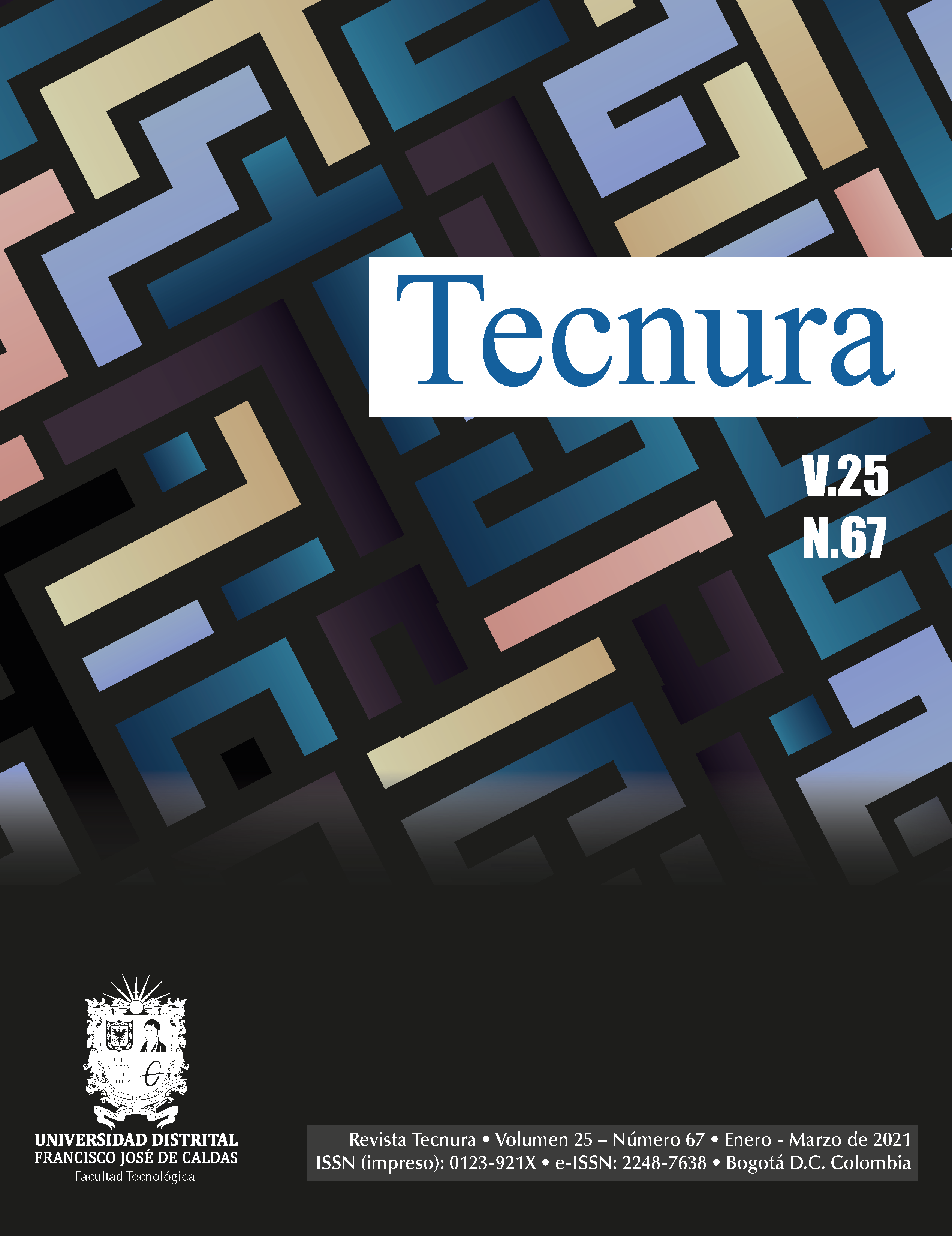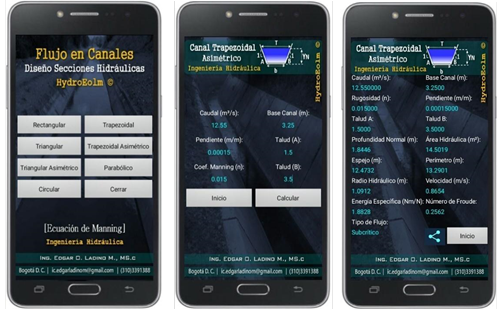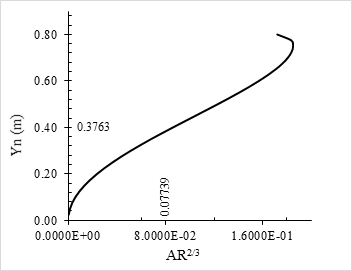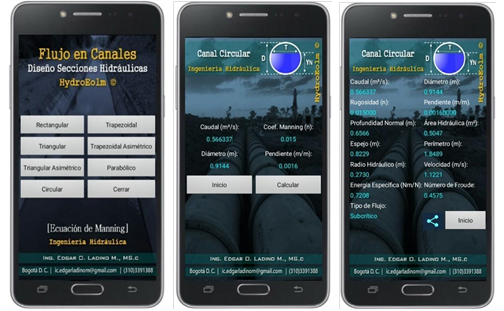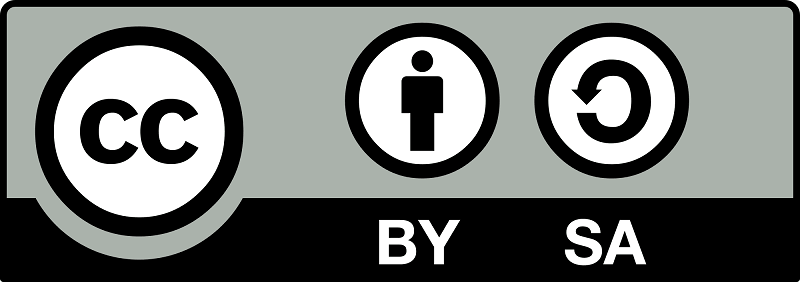DOI:
https://doi.org/10.14483/22487638.17820Publicado:
01-01-2021Número:
Vol. 25 Núm. 67 (2021): Enero - MarzoSección:
Estudio de casoDesarrollo de una aplicación móvil para el aprendizaje interactivo en problemas de ingeniería civil: aplicación a la hidráulica de canales abiertos
Development of a Mobile APP for Interactive Learning in Civil Engineering Problems: Application to Open-channel Hydraulics.
Palabras clave:
Ingenieria civil, dinámica de fluidos , aplicación informática, formación de ingenieros (es).Palabras clave:
Civil engineering, fluid dynamics, computer application, engineering education (en).Descargas
Referencias
Buck, J., McInnis, E., & Randollph, C. (2013). The new fontier of education: the impact of smartphone technology in the classroom. Proceedings of the 2013 ASEE Southeastern Section Conference 10-12 March 2013. Cookeville: ASEE .
Cameron, S., Nikora, V., & Stewart, M. (2017). Very-large-scale motions in rough-bed open-channel flow. Journal of Fluid Mechanics, 814, 416-429. doi:10.1017/jfm.2017.24
https://doi.org/10.1017/jfm.2017.24 DOI: https://doi.org/10.1017/jfm.2017.24
Chaudry, J. (2008). Open Channel Flow. New Jersey: Springer.
https://doi.org/10.1007/978-0-387-68648-6 DOI: https://doi.org/10.1007/978-0-387-68648-6
Chow, V. T. (2004). Hidráulica de Canales Abiertos. (J. Saldarriaga, Trad.) Bogotá: Mc Graw Hill.
Drumea, A. (2012). Education in development of electronic modules using free and open source software tools. Hidráulica, 3(4), 51-57.
Hsu, Y., Rice, K., & Dawley, L. (2012). Empowering educators with Google's Android App Inventor: An online workshop in mobile app design. British Journal of Educational Technology, 43(1). doi:10.1111/j.1467-8535.2011.01241.x
https://doi.org/10.1111/j.1467-8535.2011.01241.x DOI: https://doi.org/10.1111/j.1467-8535.2011.01241.x
Jou, M., Lin, Y., & Tsai, H. (2016). Mobile APP for motivation to learning: an engineering case. Interactive Learning Environments, 24(8), 2048-2057. doi:10.1080/10494820.2015.1075136
https://doi.org/10.1080/10494820.2015.1075136 DOI: https://doi.org/10.1080/10494820.2015.1075136
Kai, H., Lam, N., Zou, L., & Quiang, Y. (2018). Modeling the dynamics of community resilience to coastal hazards using a bayesian network. Annals of the American Association of Geographers, 108(5), 1260-1279. doi:10.1080/24694452.2017.1421896
https://doi.org/10.1080/24694452.2017.1421896 DOI: https://doi.org/10.1080/24694452.2017.1421896
Khan, M., & Chiang, J. (2014). Using mobile devices & social media in supporting engineering education. 2014 IEEE Global Engineering Education Conference (EDUCON) (págs. 1077-1081). Istanbul: IEEE. doi:10.1109/EDUCON.2014.6826241.
https://doi.org/10.1109/EDUCON.2014.6826241 DOI: https://doi.org/10.1109/EDUCON.2014.6826241
Marusic, I., & Hutchins, N. (julio de 2008). Study of the log-layer structure in wall turbulence ovber a very large range of reynolds number. Flow, Turbulence and Combustion, 81(1-2), 115-130. doi:10.1007/s10494-007-9116-0
https://doi.org/10.1007/s10494-007-9116-0 DOI: https://doi.org/10.1007/s10494-007-9116-0
Mirauda, D., Capece, N., & Erra, U. (2020). Sustainable water managment: Virtual reality training for open-channel flow monitoring. Sustainability, 12(3), 757. doi:10.3390/su12030757
https://doi.org/10.3390/su12030757 DOI: https://doi.org/10.3390/su12030757
Monty, J., Hutchins, N., Ng, H., Marusic, I., & Chong, M. (2009). A comparision of turbulent pipe, channel and boundary layer flows. Journal of fluid mechanics, 632, 431-442. doi:10.1017/S0022112009007423
https://doi.org/10.1017/S0022112009007423 DOI: https://doi.org/10.1017/S0022112009007423
Roy, A., Buffin-Belánger, T., Lamarre, H., & Kirkbride, A. (2004). Size, shape and dynamics of large-scale turbulent flow structures in a gravel-bed-river. Journal of Fluid Mechanics, 500(500), 1-27. doi:10.1017/S0022112003006396
https://doi.org/10.1017/S0022112003006396 DOI: https://doi.org/10.1017/S0022112003006396
Sotelo, G. (2002). Hidráulica de Canales. México: UNAM Facultad de Ingeniería.
Woods, R. (1994). Issues in implementation in an otherwise conventional programme. En The challenge of problem-based learning (págs. 173-180). London: G. I. Boud, D.& Feletti.
Cómo citar
APA
ACM
ACS
ABNT
Chicago
Harvard
IEEE
MLA
Turabian
Vancouver
Descargar cita
Recibido: 25 de junio de 2020; Aceptado: 3 de noviembre de 2020
Abstract
Context:
The analysis of water flow in open channels is a relevant topic of study in different civil engineering projects. However, traditional experiments in open channel hydraulics and scale models are limited, and simple conceptual review based solely on textbooks does not allow sufficient stimulation and motivation for students. On the other hand, the rapid development of mobile devices and programming in the cloud and mobile Operation Systems such as Android offer alternatives for the development of complementary tools that support educational processes.
Method:
This work presents the development of an application that allows the analysis and design of open prismatic channels by implementing the Newton-Raphson numerical method and incorporating a problem-based learning approach.
Results:
Interactive elements were included in the application for the definition of problem variables, as well as didactic images and friendly data outputs to promote interest in the application and understanding of the problem-solving process.
Conclusions:
The mobile application is an example of the possibilities that exist to strengthen both the teaching of concepts and the technological approach for the rapid solution of problems, which promote the appropriation of concepts in civil engineering education. The application is called "HydroEolm" and is available for free on the Google Play Store; It has been downloaded several thousand times in Latin America and the Caribbean, mostly by engineering students, so the positive impact of the application for academic training is inferred.
Keywords:
Civil engineering, fluid dynamics, computer application, engineering education.Resumen
Contexto:
El análisis del flujo de agua en canales abiertos es un tema de estudio relevante en diferentes proyectos de ingeniería civil. Sin embargo, los experimentos tradicionales en hidráulica de canales abiertos y modelos a escala son limitados, y la simple revisión conceptual basada únicamente en libros de texto no permite la suficiente estimulación y motivación para los estudiantes. Por otro lado, el rápido desarrollo de dispositivos móviles y programación en la nube a través de lenguajes como Android ofrecen alternativas para el desarrollo de herramientas complementarias que apoyen los procesos educativos.
Método:
Este trabajo presenta el desarrollo de una aplicación que permite el análisis y diseño de canales prismáticos abiertos mediante la implementación del método numérico Newton-Raphson, incorporando un enfoque de aprendizaje basado en problemas.
Resultados:
Se incluyeron en la aplicación elementos interactivos para la definición de variables del problema, imágenes didácticas y salidas de datos amigables para promover el interés en el uso de la aplicación y la comprensión de la solución de los problemas.
Conclusiones:
La aplicación móvil es un ejemplo de las posibilidades que existen para fortalecer tanto la enseñanza de conceptos como el enfoque tecnológico para la solución rápida de problemas, las cuales promueven la apropiación de conceptos en la educación de ingeniería civil. La aplicación se llama "HydroEolm" y está disponible de forma gratuita en la Play Store de Google; ha sido descargada varios miles de veces en América Latina y el Caribe, en su mayoría por estudiantes de ingeniería, así que se infiere el impacto positivo de la aplicación para el entrenamiento académico.
Palabras clave:
Ingeniería civil, dinámica de fluidos, aplicación informática, formación de ingenieros..INTRODUCTION
The study of water flow in open channels is a critical issue for multiple projects related to Civil Engineering about the evacuation of water under controlled speed and flow. Several engineering projects use surface drainage systems for the evacuation of free-flowing water at different scales, from small channels in road works and slopes (measured in centimeters) to channeling currents through channels with large hydraulic sections of several meters wide (Chaudry, 2008) (Marusic & Hutchins, 2008) (Monty, Hutchins, Ng, Marusic, & Chong, 2009) (Roy, Buffin-Belánger, Lamarre, & Kirkbride, 2004) (Cameron, Nikora, & Stewart, 2017). The optimization of the hydraulic design of these structures through numerical methods is a key component in the training of civil engineers and comes second to conducting laboratory tests on models to explain the concepts associated to the design of the hydraulic channel. (Chaudry, 2008) (Monty, Hutchins, Ng, Marusic, & Chong, 2009) (Cameron, Nikora, & Stewart, 2017). Despite the conventional presentation of the design of open channels in the training curricula of civil engineering, concerns persist in the background of students because some concepts in this topic are abstract, and in some cases they can only be understood from laboratory tests (Monty, Hutchins, Ng, Marusic, & Chong, 2009) (Cameron, Nikora, & Stewart, 2017). Particularly, students in developing countries do not always have easy access to physical laboratory models for the appropriation of concepts associated with flow in open channels. Therefore, concepts such as the hydraulic total energy line, the specific energy, the wetted perimeter, and the hydraulic radius are often confused or not sufficiently understood when referring to a real-world situation (Woods, 1994) (Mirauda, Capece, & Erra, 2020).
Considering that the hydraulic section of an open channel depends fundamentally on the relationships between roughness, flow type, fluid velocity, and flow rates through iterative processes, the preparation of a numerical solution in conventional spreadsheets is often not sufficient for long-term concept appropriation. Thus, conventional pedagogy results in restrictions on students’ imaginations and inadequate training for the development of practical skills; also, it tend to work within the boundaries of computers instead of taking advantage of more modern learning environments (Khan & Chiang, 2014) (Buck, McInnis, & Randollph, 2013) (Jou, Lin, & Tsai, 2016) (Drumea, 2012).
For hydraulic engineering education, problem-based learning (PBL) is considered an ideal learning strategy as it encourages students to take a multidisciplinary approach to the basic sciences by applying numerical methods and strengthening their skills and confidence in handling new problems (Kai, Lam, Zou, & Quiang, 2018). Consequently, the PBL methodology began to be considered a crucial key for modern engineering practice and became a central theme of development for engineering education since the end of the XX century (Woods, 1994) (Mirauda, Capece, & Erra, 2020). In this context, the implementation of numerical methods in cloud web applications have become relevant as innovative elements in the education of civil engineering students in developing countries (Woods, 1994) (Mirauda, Capece, & Erra, 2020) (Drumea, 2012).
Since 1990, the advance of wireless technologies has experienced a significant expansion in both developed and developing countries. This increase took place from the first generation of mobile telephony (analogous) to the fourth generation (digital). Currently, 5th generation mobile telephony is in its implementation stage. This advance has allowed the development of cellphones, tablets, and other smart devices of higher performance in terms of memory and processing capacity (Buck, McInnis, & Randollph, 2013) (Jou, Lin, & Tsai, 2016). In the same way, this technology has contributed to the elaboration of mobile apps in commercial, environmental, industrial, medical, and educational fields (Chaudry, 2008) (Mirauda, Capece, & Erra, 2020) (Buck, McInnis, & Randollph, 2013) (Drumea, 2012).
The increasing popularity of smart mobile devices means that many students are already familiar with their use and features (Mirauda, Capece, & Erra, 2020) (Hsu, Rice, & Dawley, 2012). Hence, there is an expected positive impact that the use of mobile devices for teaching hydraulics and other areas in civil engineering have on the motivation and effectiveness of learning within developing countries.
It is worth highlighting that there are some key aspects in educational software development to be considered, such as accessibility, simplicity, the building of high-quality documents where key concepts are synthesized, and lower cost for licensing (Marusic & Hutchins, 2008); and commercial educational software is expensive and of limited access to part of the population. Hence, free or open-source software is a better option for educational purposes in open channels since they allow users to implement their own needed software and generate new possibilities for content, mobility, and understanding (Monty, Hutchins, Ng, Marusic, & Chong, 2009) (Roy, Buffin-Belánger, Lamarre, & Kirkbride, 2004) (Mirauda, Capece, & Erra, 2020).
This work shows the development of a mobile application in Android for the analysis and design of open channels with the incorporation of a Newton-Raphson numerical solution for different geometries. Unlike the examples presented in a conventional channel hydraulics class, the application presents a wide range of examples that promote interest in the subject and act as a complementary resource to conventional education through texts, graphic aids, and friendly graphic environments (Mirauda, Capece, & Erra, 2020) (Jou, Lin, & Tsai, 2016) (Hsu, Rice, & Dawley, 2012). The mobile app has been downloaded by engineering students in Latin-American countries, which suggests the positive acceptance of this tool as a complement to university education on this topic.
Figure 1: Uniform Flow diagram (trapezoidal channel).
App Development
PBM learning approach seeks that students understand the application of concepts in real-problem civil-engineering situations. Open channels of trapezoidal or circular sections are widely used in geotechnical work (e.g. surface drainage works slope stabilization), highway projects, and hydraulic projects for flood mitigation and flow control. Then, Newton-Raphson formulation of the problem for hydraulic design optimization is applicable to any of the scenarios described.
Basic Problem
In a prismatic channel subjected to atmospheric pressure, uniform flow conditions can be established if the depth, wet area, and flow speed remain constant. That is, the slope of the bottom channel, the slope of the water surface, and the energy line are parallel; and the component of the gravitational force parallel to the flow in any laminar layer is balanced by the frictional force for a uniform laminar flow (Chaudry, 2008) (Cameron, Nikora, & Stewart, 2017). The equation that governs the flow behavior in open channels is represented by Chézy's equation, developed by Irish engineer Robert Manning (Chaudry, 2008) (Woods, 1994) (Mirauda, Capece, & Erra, 2020). This empirical development is based on the channel roughness, flow speed, water depth, and bottom slope.
Equation (1) shows Chezy's equation using SI units (Chaudry, 2008):

Where, Q: Flow (m3/s); n: Manning roughness coefficient; A: Hydraulic area (m2); P: wet perimeter (m); R: Hydraulic ratio (m); and S: Slope (m/m).
In derivative form, equation 1 can be expressed as:
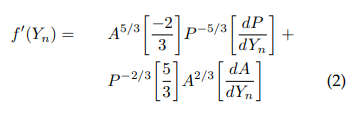
And the Newton-Raphson formulation would be (equation 3):

Development of Numerical Solution
Based on iterative and incremental processes, three stages of the solution were developed for the numerical formulation within the app. In the first stage, a flow diagram was developed for each of the hydraulic sections by using an iterative process. In the second stage, the source code was developed for Android platforms using JavaScript as it is open source and Android is based on object-oriented programming language. Finally, the third stage consisted of validating the app code by comparing its results against those calculated by other programs and exercises proposed in Hydraulics books (Chaudry, 2008). The flow chart for the user interface is presented in Figure 2. The flow of activities varies depending on the selected hydraulic section.
Figure 2: Flow diagram of user interface App (trapezoidal channel).
According to the Newton-Raphson method, the probability of divergence increases significantly if the initial value is zero or presents different inflection points. To overcome this anomaly, a method is suggested to obtain a regression of dependent and independent variables for the initial value (seed value). In the case of trapezoidal channels, a potential expression was obtained for the normal depth as a function of the flow rate, which guarantees that the method will reach convergence, regardless of the initial value moving away or being close to zero. The relative error between successive approximations in this scenario is 0.000001 meters. Figure 3 shows the algorithm used to program the solution for the trapezoidal channel. A similar formulation was implemented for the circular section.
Figure 3: Normal depth calculating flow chart (trapezoidal channel).
App Formulation and Validation
The development of the mobile application is presented below in detail for trapezoidal and circular channels, along with the Newton-Raphson type solution. The graphic aspects of data input, analysis, and output of the application in the Android environment are also presented.
Trapezoidal Channel
The first screen presents a menu showing different variables. The algorithm calculates the normal depth, hydraulic radius, specific energy, flow type, hydraulic area, wet perimeter, flow velocity, and Froude number for each of the hydraulic sections. In order to validate the app calculations, determining the normal depth for a symmetric trapezoidal channel is suggested (Figure 4), which will be done through three different methodologies (Newton-Raphson app, Goal Seek tool in Excel®, and the software Hcanales®).
The channel presents the following hydraulic conditions:
Source: Authors.
Table 1: Trapezoidal channel input data.

Figure 4: Trapezoidal channel.
Hydraulic area:

Wet perimeter:

Hydraulic ratio:

Mirror:

Specific energy:

Applying Manning equation under the uniform flow assumption (equations 1, 2 and 3), we have the variables expressed in derivative form as follows:
Hydraulic area:

Wet perimeter:

Newton-Raphson approximation:

Normal depth:

In the symmetric trapezoidal channel case, a potential model for the normal depth as a function of the flow rate for the initial value (seed value) was obtained, so it is guaranteed that the method will reach convergence, regardless of whether the initial value moves away or stays close to zero (equation 13).

Where, Q: Flow (m3/s); Y: Normal depth (meters).
Source: Authors.
Table 2: Normal depth calculation (Excel, Newton-Raphson), (trapezoidal channel).

Figure 5: Visual Code (Excel). Calculation iteration for Yn (symmetric trapezoidal channel).
The comparison of the results obtained by three different methodologies are shown in Table 3. It is possible to see that the calculations from the Android app have a high degree of precision for normal depth calculation in prismatic channels.
Source: Authors.
Table 3: Results comparison Yn, (trapezoidal channel).

Figure 6: Trapezoidal channel (Android app’s normal depth solution).
Asymmetric trapezoidal channel
To estimate the capacity that the Android app has for calculating the normal depth from the paradigm proposed by Manning, a symmetric trapezoidal channel that presents the following hydraulic conditions is proposed:
Source: Authors.
Table 4: Input parameters asymmetric trapezoidal channel.

Figure 7: Asymmetric trapezoidal channel.
Hydraulic area:

Wet perimeter:

Hydraulic ratio:

Mirror:

A potential model for the normal depth in an asymmetric trapezoidal channel as a function of the flow rate for the initial value (seed value) was obtained. This guarantees the convergence of the method, regardless of whether the initial value moves away or approaches zero.
Hydraulic area derivative:

Wet perimeter derivative:

Newton-Raphson Approximation:



Source: Authors.
Table 5: Normal depth calculation (Excel, Newton-Raphson), (asymmetric trapezoidal channel).

Figure 8: Visual Code (Excel). Iteration for Yn calculation. (asymmetric trapezoidal channel).
Source: Authors.
Table 6: Yn results comparison (asymmetric trapezoidal channel).

Figure 9: Asymmetric trapezoidal channel, (Android app’s normal depth solution)
Circular channel
The solution for a circular channel was obtained from the ratio of the flow through the pipe and the flow to full pipe, which guarantees that the algorithm developed calculates the independent normal depth whether it is below or above the radius. To evaluate the implementation, the following hydraulic problem is proposed:
Source: Authors.
Table 7: Circular channel input parameters

Figure 10: Circular channel.
Central angle:

Hydraulic area:

Wet perimeter:

Hydraulic ratio:

Mirror:

Specific energy:

Newton-Raphson approximation depending on the angle:
Function:

Derivative:

Where:



Newton-Raphson approximation according to normal depth:
Function:

Derivative:


Source: Authors.
Table 8: Yn solution (Excel - Newton-Raphson), (circular channel)

Figure 11: Visual code (Excel). Iteration for Yn calculation.
The graph in Figure 12 was constructed from the section factor for uniform flow.

Figure 12: Circular pipe, (graphic solution).
Figure 13: Circular channel (app’s normal depth calculation).
Source: Authors.
Table 9: Yn results comparison, (circular channel).

Finally, the calculations made by the app were evaluated using exercises proposed in different Hydraulics books (Chaudry, 2008) and their respective solutions to confirm the accuracy of the app. The results are presented in Tables 10, 11, and 12. Likewise, the results calculated by the app are shown in Figures 14, 15, and 16.
Source: Authors.
Table 10: Results comparison - Exercise 2.7, “Hidráulica de canales.”

Source: Authors.
Table 11: Results comparison - Exercise 6.2, “Hidráulica de canales abiertos.”

Source: Authors.
Table 12: Results comparison - Exercise 6.3, “Hidráulica de canales

Figure 14: Exercise 2.7, Hidráulica de canales, Gilberto Sotelo (app’s normal depth calculation).
Figure 15: Exercise 6.2, Hidráulica de canales abiertos, Ven Te Chow
(app’s normal depth calculation).
Figure 16: Exercise 6.3, Hidráulica de canales abiertos, Ven Te Chow
(app’s normal depth calculation).
App Impact from Google Play Store
App Hydroelm has had over 7000 downloads over a period of 10 months since it was released in the Google Play Store. A follow up shows that the downloads have occurred mainly in Central and South American countries (Peru 40%, Colombia 20%, Guatemala 20%, and Honduras 20%). Within the percentage of downloads in each country, more than 80% correspond to college students (Peru 86%, Colombia 92%, Guatemala 81%, and Honduras 88%). The rating of the app exceeds 4.5 points; this value constitutes an indirect indication of the positive impact the tool has had in strengthening the learning of this subject in engineering students from developing countries. Although the motivation of the assessment is not clear, it is possible to infer that the app constitutes a useful tool in the educational environment, either to corroborate results of manual calculation exercises or electronic sheets by students. It is also a reflection of the impact of using digital media on smartphones for the appropriation of knowledge in a modern education practice on topics in civil engineering.
CONCLUSIONS
The algorithm implemented for the app “HydroEolm Hydraulic Channel Design” avoids the use of nomograms and optimizes the calculation process for the normal depth and other hydraulic parameters in open channels. The assessment of the results shows the accuracy of the calculations for various hydraulic sections and confirms the reliability of the tool for process designing.
The app indicates an accuracy of 10-6 meters for the calculations. This is a good result compared to other methods like electronic sheets. Thus, the app’s effectiveness for solving hydraulics problems for prismatic channels is demonstrated. This was validated by comparing the results in the app against the results obtained from three different methodologies (Goal Seek, Newton-Raphson, and Hcanales®). For future developments it will be possible to include an integration with web and mobile interfaces for a massive diffusion.
From the number of downloads of the app within developing countries, it is possible to infer the wide acceptance specialized public has towards this tool, probably due to its contribution to explaining concepts and its usability in the educational field.
References
Licencia
Esta licencia permite a otros remezclar, adaptar y desarrollar su trabajo incluso con fines comerciales, siempre que le den crédito y concedan licencias para sus nuevas creaciones bajo los mismos términos. Esta licencia a menudo se compara con las licencias de software libre y de código abierto “copyleft”. Todos los trabajos nuevos basados en el tuyo tendrán la misma licencia, por lo que cualquier derivado también permitirá el uso comercial. Esta es la licencia utilizada por Wikipedia y se recomienda para materiales que se beneficiarían al incorporar contenido de Wikipedia y proyectos con licencias similares.

